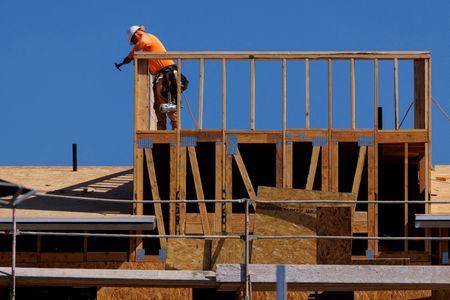By Lucia Mutikani
WASHINGTON (Reuters) – U.S. single-family homebuilding rebounded sharply in February, hitting the highest level in nearly two years, boosted by mild temperatures and a persistent shortage of previously owned houses on the market.
Despite the hurdle created for many first-time buyers by higher mortgage rates, builders are cutting prices and offering other incentives to increase sales. They are also reducing the size of the homes being built to manage higher material costs.
The report from the Commerce Department on Tuesday also showed permits for the future construction of single-family housing units rose to more than a 1-1/2-year high last month. With mortgage rates gradually trending lower on expectations the Federal Reserve will start cutting interest rates by June, homebuilding could contribute to economic growth this year.
“Single-family starts could remain strong in the next couple of months as builders continue to see demand for new builds despite the headwinds facing buyers,” said Daniel Vielhaber, an economist at Nationwide. “Rate incentives from builders continue to help buyers afford homes on the new side of the market.”
Single-family housing starts, which account for the bulk of homebuilding, surged 11.6% to a seasonally adjusted annual rate of 1.129 million units last month, the Commerce Department’s Census Bureau said. That was the highest level since April 2022.
Data for January was revised up to show single-family starts falling to a rate of 1.012 million units instead of the previously reported 1.004 million units.
Though the housing market has been pummeled by aggressive rate hikes from the U.S. central bank as it battles inflation, homebuilding has been supported by an acute housing shortage, with most homeowners locked into lower mortgage rates.
Recent government data showed there were 757,000 housing units for sale in the fourth quarter, well below the 1.145 million units before the COVID-19 pandemic.
A survey from the National Association of Home Builders on Monday showed confidence among single-family home builders rose to an eight-month high in March amid optimism about sales now and over the coming six months.
Fed officials were expected to leave the central bank’s policy rate unchanged in the current 5.25%-5.50% range at the end of a two-day meeting on Wednesday, having raised it by 525 basis points since March 2022.
The average rate on the popular 30-year fixed-rate mortgage has retreated in recent weeks after flirting with the 7% level in late February, according to data from mortgage finance agency Freddie Mac.
Single-family homebuilding jumped 40.2% in the Midwest and increased 16.6% in the densely populated South. It accelerated 16.4% in the Northeast, but declined 15.4% in the West.
Starts for housing projects with five units or more advanced 8.6% to a rate of 377,000 units.
Overall housing starts increased 10.7% to a rate of 1.521 million units in February. Economists polled by Reuters had forecast starts would rebound to a rate 1.425 million units.
Single-family building permits rose 1.0% to a rate of 1.031 million units in February, the highest level since May 2022. Multi-family building permits rose 2.4% to a rate of 429,000 units. Building permits as a whole climbed 1.9% to a rate of 1.518 million units.
Homebuilding activity this year is expected to be concentrated in the single-family housing segment amid a huge backlog of multi-family units under construction.
Residential investment rebounded in the second half of 2023 after contracting for nine straight quarters, the longest such stretch since the housing market collapse in 2006. It has been a drag on gross domestic product for two straight years.
“Housing construction is likely to add modestly to economic growth in the months ahead as builders look forward to the Fed rate cuts that policymakers are forecasting for later this year,” said Christopher Rupkey, chief economist at FWDBONDS. “Housing construction has likely turned the corner in this economic cycle and will cease to be a drag on the overall economy.”
A minority of economists believe the Fed will not cut rates this year, especially if inflation remains elevated.
Stocks on Wall Street mostly were trading lower. The dollar gained versus a basket of currencies. Prices of U.S. Treasuries rose.
MORE COMPLETIONS
The number of houses approved for construction that were yet to be started increased 0.4% to 270,000 units in February. The single-family homebuilding backlog fell 1.4% to 141,000 units. The completions rate for that housing segment surged 20.2% to 1.072 million units, the highest level since November 2022.
Overall housing completions soared 19.7% to a rate of 1.729 million units, the highest level since January 2007. That is goods news for supply, which is keeping house prices high and contributing to rental inflation.
Realtors estimate that housing starts and completion rates need to be in a range of 1.5 million to 1.6 million units per month over time to bridge the inventory gap.
The number of housing units under construction slipped 0.5% to a rate of 1.666 million units. The inventory of single-family housing under construction rose 0.3% to a rate of 683,000 units.
The stock of multi-family housing under construction dropped 1.0% to 966,000 units. Multi-family housing inventory under construction hit a record 1.001 million units in July 2023. An increased supply of apartments will slow growth in rental prices, the major driver of inflation.
“More multi-family units should continue to weigh on rental inflation, which is decelerating but still elevated,” said Nancy Vanden Houten, U.S. lead economist at Oxford Economics.
(Reporting by Lucia Mutikani; Editing by Kirsten Donovan and Paul Simao)

